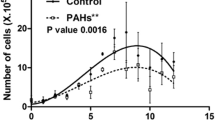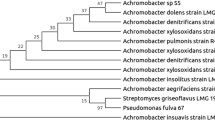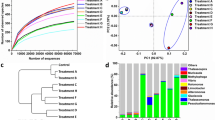Abstract
A physico-chemical characterization of seawater taken from the fishing harbour of Sfax, Tunisia, revealed a contamination by organic and inorganic micropollutants. An aerobic marine halotolerant Bacillus stratosphericus strain FLU5 was isolated after enrichment on fluoranthene, a persistent and toxic polycyclic aromatic hydrocarbon (PAH). GC-MS analyses showed that strain FLU5 was capable of degrading almost 45 % of fluoranthene (100 mg l−1), without yeast extract added, after 30 days of incubation at 30 g l−1 NaCl and 37 °C. In addition, the isolate FLU5 showed a remarkable capacity to grow on a wide range of aliphatic, aromatic and complex hydrocarbons. This strain could also synthesize a biosurfactant which was capable of reducing the surface tension of the cell-free medium, during the growth on fluoranthene. The biodegradative abilities of PAHs are promising and can be used to perform the bioremediation strategies of seawaters and marine sediments contaminated by hydrocarbons.





Similar content being viewed by others
References
Benson DA, Boguski MS, Lipman DJ, Ostell J, Ouellette BF, Rapp BA, Wheeler DL (1999) GenBank. Nucleic Acids Res 27:12–17
Cao J, Lai Q, Yuan J, Shao Z (2015) Genomic and metabolic analysis of fluoranthene degradation pathway in Celeribacter indicus P73T. Sci Rep 5:7741
Cerniglia CE (1992) Biodegradation of polycyclic aromatic hydrocarbons. Biodegradation 3:351–368
Chamkha M, Record E, Garcia J-L, Asther M, Labat M (2002) Isolation from a shea cake digester of a tannin-tolerant Escherichia coli strain decarboxylating p-hydroxybenzoic and vanillic acids. Curr Microbiol 44:341–349
Chamkha M, Trabelsi Y, Mnif S, Sayadi S (2011) Isolation and characterization of Klebsiella oxytoca strain degrading crude oil from a Tunisian off-shore oil field. J Basic Microb 51:580–589
Chebbi A, Jaoua H, Loukil S, Mhiri N, Ammar N, Sayadi S, Chamkha M (2016) Biodegradation of malodorous mercaptans by a novel Staphylococcus capitis strain isolated from gas-washing wastewaters of the Tunisian Chemical Group. Int J Environ Sci Technol 13:571–580
D’Adamo R, Di Stasio M, Fabbrocini A, Petitto F, Roselli L, Volpe MG (2008) Migratory crustaceans as biomonitors of metal pollution in their nursery areas. The Lesina lagoon (SE Italy) as a case study. Environ Monit Assess 143:15–24
Da Cunha CD, Rosado AS, Sebastián GV, Seldin L, von der Weid I (2006) Oil biodegradation by Bacillus strains isolated from the rock of an oil reservoir located in a deep-water production basin in Brazil. Appl Microbiol Biot 73:949–959
Danulat E, Muniz P, García-Alonso J, Yannicelli B (2002) First assessment of the highly contaminated harbour of Montevideo, Uruguay. Mar Pollut Bull 44:554–565
Das K, Mukherjee AK (2007a) Differential utilization of pyrene as the sole source of carbon by Bacillus subtilis and Pseudomonas aeruginosa strains: role of biosurfactants in enhancing bioavailability. J Appl Microbiol 102:195–203
Das K, Mukherjee AK (2007b) Crude petroleum-oil biodegradation efficiency of Bacillus subtilis and Pseudomonas aeruginosa strains isolated from a petroleum-oil contaminated soil from North-East India. Bioresource Technol 98:1339–1345
De França ÍWL, Lima AP, Lemos JAM, Lemos CGF, Melo VMM, de Sant’ana HB, Gonçalves LRB (2015) Production of a biosurfactant by Bacillus subtilis ICA56 aiming bioremediation of impacted soils. Catal Today 255:10–15
Đokić L, Narančić T, Nikodinovic-Runic J, Bajkić S, Vasiljević B (2011) Four Bacillus sp. soil isolates capable of degrading phenol, toluene, biphenyl, naphthalene and other aromatic compounds exhibit different aromatic catabolic potentials. Arch Biol Sci 63:1057–1067
Faragallah H, Askar A, Okbah M, Moustafa H (2009) Physico-chemical characteristics of the open Mediterranean sea water far about 60 Km from Damietta harbor, Egypt. J Ecol Nat Environ 1:106–119
Felsenstein J (1985) Confidence limits on phylogenies: an approach using the bootstrap. Evolution 39:783–791
Fernando Bautista L, Sanz R, Carmen Molina M, González N, Sánchez D (2009) Effect of different non-ionic surfactants on the biodegradation of PAHs by diverse aerobic bacteria. Int Biodeter Biodegr 63:913–922
Ferradji FZ, Mnif S, Badis A, Rebbani S, Fodil D, Eddouaouda K, Sayadi S (2014) Naphthalene and crude oil degradation by biosurfactant producing Streptomyces spp. isolated from Mitidja plain soil (North of Algeria). Int Biodeterior Biodegradation 86:300–308
Fuchedzhieva N, Karakashev D, Angelidaki I (2008) Anaerobic biodegradation of fluoranthene under methanogenic conditions in presence of surface-active compounds. J Hazard Mater 153:123–127
Gerchman Y, Patichov R, Zeltzer T (2012) Lipolytic, proteolytic, and cholesterol-degrading bacteria from the human cerumen. Curr Microbiol 64:588–591
Gordon L, Dobson ADW (2001) Fluoranthene degradation in Pseudomonas alcaligenes PA-10. Biodegradation 12:393–400
Hall T (1999) BioEdit: a user-friendly biological sequence alignment editor and analysis program for Windows 95/98/NT. Nucl Acid S 41:95–98
Hickey AM, Gordon L, Dobson ADW, Kelly CT, Doyle EM (2007) Effect of surfactants on fluoranthene degradation by Pseudomonas alcaligenes PA-10. Appl Microbiol Biot 74:851–856
Hilyard EJ, Jones-Meehan JM, Spargo BJ, Hill RT (2008) Enrichment, isolation, and phylogenetic identification of polycyclic aromatic hydrocarbon-degrading bacteria from Elizabeth River sediments. Appl Environ Microb 74:1176–1182
Hosseini-Abari A, Emtiazi G, Lee S-H, Kim B-G, Kim J-H (2014) Biosynthesis of silver nanoparticles by Bacillus stratosphericus spores and the role of dipicolinic acid in this process. Appl Biochem Biotech 174:270–282
Hunter RD, Ekunwe SIN, Dodor DE, Hwang H-M, Ekunwe L (2005) Bacillus subtilis is a potential degrader of pyrene and benzo[a]pyrene. Int J Environ Res Public Health 2:267–271
Jukes TH, Cantor CR (1969) Evolution of protein molecules. In: Munro HN (ed) Mammalian protein metabolism. Academic Press, New York, pp 21–132
Kebbouche-Gana S, Gana ML, Khemili S, Fazouane-Naimi F, Bouanane NA, Penninckx M, Hacene H (2009) Isolation and characterization of halophilic Archaea able to produce biosurfactants. J Ind Microbiol Biot 36:727–738
Kelley I, Freeman JP, Evans FE, Cerniglia CE (1993) Identification of metabolites from the degradation of fluoranthene by Mycobacterium sp. strain PYR-1. Appl Environ Microb 59:800–806
Kumar S, Upadhayay SK, Kumari B, Tiwari S, Singh SN, Singh PK (2011) In vitro degradation of fluoranthene by bacteria isolated from petroleum sludge. Bioresource Technol 102:3709–3715
Kweon O, Kim SJ, Jones RC, Freeman JP, Adjei MD, Edmondson RD, Cerniglia CE (2007) A polyomic approach to elucidate the fluoranthene-degradative pathway in Mycobacterium vanbaalenii PYR-1. J Bacteriol 189:4635–4647
Lima A de S, Cabral A, Andreote FD, Cavalett A, Pessatti ML, Dini-Andreote F, da Silva M (2013) Draft genome sequence of Bacillus stratosphericus LAMA 585, isolated from the Atlantic deep sea. Genome Announcements 1(3):e00204–e00213
Lin C, Gan L, Chen Z (2010) Biodegradation of naphthalene by strain Bacillus fusiformis (BFN). J Hazard Mater 182:771–777
Liu J-H, Maity JP, Jean J-S, Chen C-Y, Chen C-C, Ho S-Y (2010) Biodegradation of benzene by pure and mixed cultures of Bacillus spp. World J Microb Biot 26:1557–1567
Logan NA, Berkeley RCW (1984) Identification of Bacillus Strains Using the API System. Microbiology 130:1871–1882
López Z, Vila J, Grifoll M (2005) Metabolism of fluoranthene by mycobacterial strains isolated by their ability to grow in fluoranthene or pyrene. J Ind Microbiol Biotechnol 32:455–464
Louati A, Elleuch B, Kallel M, Saliot A, Dagaut J, Oudot J (2001) Hydrocarbon contamination of coastal sediments from the Sfax area (Tunisia), Mediterranean Sea. Mar Pollut Bull 42:445–452
Maiti A, Das S, Bhattacharyya N (2012) Bioremediation of high molecular weight polycyclic aromatic hydrocarbons by Bacillus thuringiensis strain NA2. Journal of Science 1:72–75
Maliji D, Olama Z, Holail H (2013) Environmental studies on the microbial degradation of oil hydrocarbons and its application in Lebanese oil polluted coastal and marine ecosystem. Int J Curr Microbiol Appl Sci 2:1–18
Mnif S, Chamkha M, Sayadi S (2009) Isolation and characterization of Halomonas sp. strain C2SS100, a hydrocarbon-degrading bacterium under hypersaline conditions. J Appl Microbiol 107:785–794
Mnif S, Chamkha M, Labat M, Sayadi S (2011) Simultaneous hydrocarbon biodegradation and biosurfactant production by oilfield-selected bacteria. J Appl Microbiol 111:525–536
Mnif S, Sayadi S, Chamkha M (2014) Biodegradative potential and characterization of a novel aromatic-degrading bacterium isolated from a geothermal oil field under saline and thermophilic conditions. Int Biodeter Biodegr 86:258–264
Mukherjee A, Bordoloi N (2012) Biodegradation of benzene, toluene, and xylene (BTX) in liquid culture and in soil by Bacillus subtilis and Pseudomonas aeruginosa strains and a formulated bacterial. Environ Sci Pollut R 19:3380–3388
Palmisano M, Nakamura LK, Duncan KE, Istock CA, Cohan FM (2001) Bacillus sonorensis sp. nov., a close relative of Bacillus licheniformis, isolated from soil in the Sonoran Desert, Arizona. Int J Syst Evol Micr 51:1671–1679
Pandey S, Sree A, Dash SS, Sethi DP, Chowdhury L (2013) Diversity of marine bacteria producing beta-glucosidase inhibitors. Microb Cell Fact 12:35
Readman J, Fillmann G, Tolosa I, Bartocci J, Villeneuve J-P, Catinni C, Mee LD (2002) Petroleum and PAH contamination of the Black Sea. Mar Pollut Bull 44:48–62
Rehmann K, Hertkorn N, Kettrup AA (2001) Fluoranthene metabolism in Mycobacterium sp. strain KR20: identity of pathway intermediates during degradation and growth. Microbiology 147:2783–2794
Saitou N, Nei M (1987) The neighbor-joining method: a new method for reconstructing phylogenetic trees. Mol Biol Evol 4:406–425
Sang-Cheol L, Kim SH, Park IH, Chung SY, Chandra MS, Yong-Lark C (2010) Isolation, purification, and characterization of novel fengycin S from Bacillus amyloliquefaciens LSC04 degrading-crude oil. Biotechnol Bioprocess Eng 15:246–253
Šepič E, Bricelj M, Leskovšek H (1997) Biodegradation studies of polyaromatic hydrocarbons in aqueous media. J Appl Microbiol 83:561–568
Šepič E, Bricelj M, Leskovšek H (1998) Degradation of fluoranthene by Pasteurella sp. IFA and Mycobacterium sp. PYR‐1: isolation and identification of metabolites. J Appl Microbiol 85:746–754
Shivaji S, Chaturvedi P, Suresh K, Reddy GSN, Dutt CBS, Wainwright M, Narlikar JV, Bhargava PM (2006) Bacillus aerius sp. nov., Bacillus aerophilus sp. nov., Bacillus stratosphericus sp. nov. and Bacillus altitudinis sp. nov., isolated from cryogenic tubes used for collecting. Int J Syst Evol Micr 56:1465–1473
Siddikee MA, Chauhan PS, Anandham R, Han G-H, Sa T (2010) Isolation, characterization, and use for plant growth promotion under salt stress, of ACC deaminase-producing halotolerant bacteria derived from coastal soil. J Microbiol Biotechn 20:1577–1584
Silva SNRL, Farias CBB, Rufino RD, Luna JM, Sarubbo LA (2010) Glycerol as substrate for the production of biosurfactant by Pseudomonas aeruginosa UCP0992. Colloids Surfaces B Biointerfaces 79:174–183
Srinivas T (2008) Environmental Biotechnology. New Age International Publishers, New Delhi, p 10
Story SP, Parker SH, Hayasaka SS, Riley MB, Kline EL (2001) Convergent and divergent points in catabolic pathways involved in utilization of fluoranthene, naphthalene, anthracene, and phenanthrene by Sphingomonas paucimobilis var. EPA505. J Ind Microbiol Biot 26:369–382
Su D, Li P, Frank S, Xiong X (2006) Biodegradation of benzo[a]pyrene in soil by Mucor sp. SF06 and Bacillus sp. SB02 co-immobilized on vermiculite. J Environ Sci 18:1204–1209
Tamura K, Stecher G, Peterson D, Filipski A, Kumar S (2013) MEGA6: Molecular Evolutionary Genetics Analysis version 6.0. Mol Biol Evol 30:2725–2729
Tiehm A (1994) Degradation of polycyclic aromatic hydrocarbons in the presence of synthetic surfactants. Appl Environ Microb 60:258–263
van Herwijnen R, Wattiau P, Bastiaens L, Daal L, Jonker L, Springael D, Govers HAJ, Parsons JR (2003) Elucidation of the metabolic pathway of fluorene and cometabolic pathways of phenanthrene, fluoranthene, anthracene and dibenzothiophene by Sphingomonas sp. LB126. Res Microbiol 154:199–206
Viaroli P, Bartoli M, Giordani G, Magni P, Welsh DT (2004) Biogeochemical indicators as tools for assessing sediment quality/vulnerability in transitional aquatic ecosystems. Aquatic Conservation: Marine and Freshwater Ecosystems 14:19–29
Volkman J, Holdsworth D, Neil G, Bavor HJ Jr (1992) Identification of natural, anthropogenic and petroleum hydrocarbons in aquatic sediments. Sci Total Environ 112:203–219
Wang L, Qiao N, Sun F, Shao Z (2008) Isolation, gene detection and solvent tolerance of benzene, toluene and xylene degrading bacteria from nearshore surface water and Pacific Ocean sediment. Extremophiles 12:335–342
Wang W, Wang L, Shao Z (2010) Diversity and abundance of oil-degrading bacteria and alkane hydroxylase (alkB) genes in the subtropical seawater of Xiamen Island. Microb Ecol 60:429–439
Weissenfels WD, Beyer M, Klein J, Rehm HJ (1991) Microbial metabolism of fluoranthene: isolation and identification of ring fission products. Appl Microbiol Biot 34:528–535
Widdel F, Pfennig N (1981) Studies on dissimilatory sulfate-reducing bacteria that decompose fatty acids. Arch Microbiol 129:395–400
Winker S, Woese CR (1991) A definition of the domains Archaea, Bacteria and Eucarya in terms of small subunit ribosomal RNA characteristics. Syst Appl Microbiol 14:305–310
Witt G (1995) Polycyclic aromatic hydrocarbons in water and sediment of the Baltic Sea. Mar Pollut Bull 31:237–248
Xu HX, Wu HY, Qiu YP, Shi XQ, He GH, Zhang JF, Wu JC (2011) Degradation of fluoranthene by a newly isolated strain of Herbaspirillum chlorophenolicum from activated sludge. Biodegradation 22:335–345
Yadav S, Kaushik R, Saxena A, Arora D (2011) Genetic and functional diversity of Bacillus strains in the soils long-term irrigated with paper and pulp mill effluent. J Gen App Microbiol 57:183–195
Zaghden H, Kallel M, Louati A, Elleuch B, Oudot J, Saliot A (2005) Hydrocarbons in surface sediments from the Sfax coastal zone, (Tunisia) Mediterranean Sea. Mar Pollut Bull 50:1287–1294
Zaghden H, Kallel M, Elleuch B, Oudot J, Saliot A (2007) Sources and distribution of aliphatic and polyaromatic hydrocarbons in sediments of Sfax, Tunisia, Mediterranean Sea. Mar Chem 105:70–89
Zhang J, Zhang E, Scott K, Grant Burgess J (2012) Enhanced electricity production by use of reconstituted artificial consortia of estuarine bacteria grown as biofilms. Environ Sci Technol 46:2984–2992
Zhong Y, Luan T, Lin L, Liu H, Tam NFY (2011) Production of metabolites in the biodegradation of phenanthrene, fluoranthene and pyrene by the mixed culture of Mycobacterium sp. and Sphingomonas sp. Bioresource Technol 102:2965–2972
Acknowledgments
This work was supported by a grant provided by the Tunisian Ministry of Higher Education and Scientific Research and the Hubert Curien Program (CMCU 15G0808) supported by the French Ministry of Foreign Affairs and the Tunisian Ministry of Higher Education and Scientific Research. We thank Mrs. Manel Chalbi and Mrs. Najla Mhiri for their help with molecular techniques, Miss. Lobna Jlail and Mrs. Fatma Rezgui for their technical assistance in GC-MS analyses and Mr. Nidhal Baccar for his technical assistance in atomic absorption analysis.
Author information
Authors and Affiliations
Corresponding author
Additional information
Responsible editor: Robert Duran
Rights and permissions
About this article
Cite this article
Hentati, D., Chebbi, A., Loukil, S. et al. Biodegradation of fluoranthene by a newly isolated strain of Bacillus stratosphericus from Mediterranean seawater of the Sfax fishing harbour, Tunisia. Environ Sci Pollut Res 23, 15088–15100 (2016). https://doi.org/10.1007/s11356-016-6648-7
Received:
Accepted:
Published:
Issue Date:
DOI: https://doi.org/10.1007/s11356-016-6648-7




